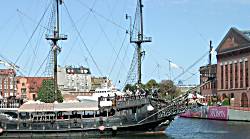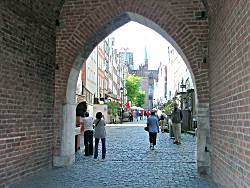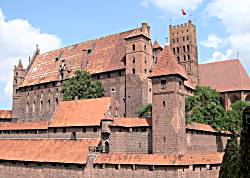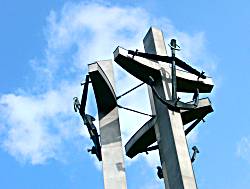
|
The world of non-commercial film and A-V |
Events Diary | Search | ||
| The Film and Video Institute | | ||||
Even in September we could eat lunch and dinner fresco. As we sipped good Polish beer and nibbled tasty pirogi, there was usually a cry of greeting as we were hailed by friends from around the world, who would join us. It had to be UNICA ...
UNICA 2009 - The Event
We love going to UNICA festivals. There are great films, lovely people and interesting places to visit. But when this one came along we were not expecting too much. Gdansk is an unromantic name reminding us of the shipyards where the Solidarity Movement began. But in earlier times the town was known as Danzig and had a reputation as one of the gems of the Baltic ports. It has been a trading point for centuries and specialises in amber - which is, or was, simply washed up on the shore.
 Modern
Gdansk is a large city with those dockyards still active, vast housing tracts,
shopping malls ... and in the centre an area where the old town has been
restored from the rubble of the second world war. That is where UNICA 2009
took place. The city is a port at the mouth of the Motlawa River, which
is itself a branch in the delta of the River Vistula. Over the centuries
the river changed course and cut new channels. That part of the town is a
series of islands linked by bridges and ferries. On Olowianka Island stands
the new Baltic Philharmonic Hall with a superb theatre space, restaurant
and side rooms. The island also boasts two top hotels and the excellent Polish
Maritime Museum.
Modern
Gdansk is a large city with those dockyards still active, vast housing tracts,
shopping malls ... and in the centre an area where the old town has been
restored from the rubble of the second world war. That is where UNICA 2009
took place. The city is a port at the mouth of the Motlawa River, which
is itself a branch in the delta of the River Vistula. Over the centuries
the river changed course and cut new channels. That part of the town is a
series of islands linked by bridges and ferries. On Olowianka Island stands
the new Baltic Philharmonic Hall with a superb theatre space, restaurant
and side rooms. The island also boasts two top hotels and the excellent Polish
Maritime Museum.
We were met at the airport by some of the organisers, who helped us get taxis to our hotels. Although most tourists are German, many of the Poles we met had good English. Getting around and finding things was not hard. Most hotels were a few minutes walk from the Philharmonic Hall. During the week there were several excursions. It was a treat.
The Baltic Philharmonic hall is a raked auditorium with seats that were very comfortable even after a whole day of viewing. The projection and sound were excellent.
The opening gala entertainment was by children studying violin under the Suzuki method. I had an idea this was something to do with motor-cycles, but I was wrong. At first a boy of around 8 years old appeared with an adult in tow. The adult was his piano accompanist and knew his place: the kid was the star. He played a beautiful piece, perfectly. Then a whole raft of children from 11 down to 2 years old came on - all dressed uniformly, boys in grey flannel trousers and white open-necked shirt, girls in blue-and-white pinafore dresses. Led by a slightly formidable lady, different groups of them played short pieces. The level of difficulty varied but each group did very well. When the tiniest ones were playing, the conductor softened, kneeling down to gently coax one girl to face forward and a shy boy to lift his violin a little.
Later in the week came another musical offering. It was a rock band with light show. Suffice to say that Jan and I heard them rehearsing and decided to go out for dinner instead. As we sat sipping soup we made bets on how many people would emerge after 5, 20, 15 minutes and so on. Before long we were joined by a host of escapees.
 Seeing
the old town
Seeing
the old town
A walking tour of the old town was our first excursion. we began by taking the ferry across to the "mainland" a voyage of about 60 seconds A series of guides split us up into different language groups for a walking tour which lasted more than two hours and introduced us to most of the principal sites. The city mayor opened the town's museum specially for us and welcomed us. Later in the week there was ample free time for us to pop back for a more detailed look at some of the special places ... and on one crazy day to climb over 600 steps to the top of the Marienkirche tower for a bird's eye view of Gdansk. At the end of this tramp we were deposited in a night-club for a snack. Not long afterward you could find most delegates and much laughter in the many excellent pavement cafes.
The Festival and Jury
Films were shown in national blocks. Each nation has around an hour to show whatever it chooses. The jury (for details of them and their awards see here) came on stage after every couple of blocks to give their first impressions of each film. Their views sometimes changed by the end of the week when it came to the final, tense voting for medals. Behind the scenes they conversed in English. On stage there was mainly a mix on English and German with the lone Frenchman gamely speaking his country's language. In the audience translators - official and voluntary - sat with groups around them and whispered a running translation of what was being said. Eventually the French speakers were able to enjoy headset translations thanks to a set of kit privately owned by a member of the committee. It all worked remarkably well. One large English-speaking group enjoyed translation from German by Romy Van Krieken and from French by Reg Lancaster. The Anglophones were not just the Brits but delegates from many other nations, for whom English is the second language: Swedes, Finns, Georgians, Estonians among them.
The jury members quickly developed public personae. Tomasz was tired but passionate and often spoke rapidly in Polish to a translator by his side who voiced his thoughts in German. Pawel was laid back and more keen of the dramatic presentation than technicalities. Dario was blunt but precise in his comment and concentrated on technicalities. Krista's main concern was using the techniques available to hook the audience. Daniel spoke with sympathy for the authors (film makers) and showed genuine delight in the best films. Ctirad (Radek) added his wry humour, sometimes to defuse tension and sometimes to make a point. ("We have seen five fine films from .... How many amateur films have we seen?"). Wolfgang played the artsy role and had sympathy for experimental film but had real insight in his remarks. The audience would have loved to have had a chance to join in the debate, especially on occasions when it seemed as if the jury had missed the point of a film. That system is used for Austria's Festival of Nations, but time did not allow its use here. One problem with spontaneous remarks in what was mainly a second or third language is that the jury does not always express it understanding of films.Towards the end of the week they showed signs of fatigue. But overall the entries had a good assessment. When it came to voting medals they were tougher than in previous years.
Thee national film programmes varied enormously. Some nations offered slick productions others much more basic ones. Bulgaria's was mentioned as the poorest, but I noticed that its choice of films managed to show how attractive that country can be and it made a good advertisement for its bid to host UNICA in 2012. The Netherlands had two fiction films from a director and club who are clearly on a high at the moment. We saw documentaries, travelogues, dramas, horrors, science fiction, comedy, satire, politics, experimental ... almost every type of film. France sent four excellent and very different dramas, including two which British readers may have seen about BIAFF and Guernsey: Decalage Horreur and Quand Paola Part - the first a dramatised documentary about a sectarian killing in Bosnia, the response of a pair of journalists and the eventual apathy of the public to it. The second a comic fable about a loser family and their run-down garage. The French continued with The Least We Can Do a tragic tale of lovers for whom even the arrival of a baby is not enough to overcome the husband's problems. The last of their block was witty, funny and called Small Change based on a beggar whose chosen spot is near a cash machine. This brought the house down.
For details of all the Awards click here.
The World Minute Movie Cup is a fun evening. From the minute movies entered a pre-jury picks 16 which are then played off against each other in heats. The winner each time is chosen by audience vote so after each two films we had to stand to indicate our vote for this or for that. It has the fun of participation, the frustration of two good films clashing in the first round which means one will be knocked out at the start and so on. Our British entry, Flicker was admired but beaten in round one. Perhaps inevitably the winners tend to be engaging comedies.
Behind the scenes there is a jeunesse programme - where young authors (film makers under 25) from many countries get together for workshops, fun and making contacts. At the final gala we saw some of their productions on the theme of Gdansk. Hamish Anderson from UK was one of the older people in this group and was seen all over the place. He formed a good friendship with a Finnish film maker and planned to go on to Finland a couple of weeks after UNICA.
A Day of History
There was a whole day outing - a necessary break between programmes of films.
First we went to Gydnia to visit ORP Blyskawica - a 1937 naval destroyer which is honoured and preserved as a museum. We explored the ship, even going through a specially cut open boiler so that we could understand how it worked and was one of the fastest ships of its type. While we did so a Navy band marched onto the dockside and began to play. We crowded the ship's rail and perched on superstructure to watch and listen. They played a mix of patriotic marches and film music specially for us.
Then we went on to the Kaszuby forest for what was billed as "an upside down house" and "the longest plank in the world". Both were indeed present and much more besides. The plank is a piece of Douglas fir 36 m and 83 cm long. It took 50 men to lift up to the wall where it is displayed in the long restaurant gallery where we had a fine buffet meal. The house looked like some debris after a hurricane. Inside it was in part just another "crazy house" of the kind beloved by fairgrounds the world over but part a symbol of the overthrow of the communist regime. That strange mix of cultural memorial and theme park attraction seemed to run throughout. We saw part of a classic steam train hitched to some wagons which had taken prisoners to the concentrations camps. There was a dormitory hut from the part of Siberia to which thousands of Poles were sent ... the cold so intense that those on the outer edges often froze to death. We sat in a blacked-out, dug-out bunker as realistic sounding bombs, thundered above us. It was appropriate that the elaborate grace said before our meal spoke of peace between peoples.
 The final part of this trip was a visit to Malbork Castle built
by the Knights of the Teutonic Order in the late 13th century and is
the largest brick gothic castle in the world. An inspired group of guides
led us on a tour.("No dates! I want you to know the people who lived here
and how they worked in this place.") And they did bring it all to life
for us. What a difference an inspired and talented teacher can make! The
castle has symbolic importance for Poles and despite serious damage in World
War II when it was used as an arsenal by the Germans it has mainly been restored
to its old glory. The chapel remains in its damaged state and may or may
not eventually be restored. When we visited it was a poignant reminder of
what had been.
The final part of this trip was a visit to Malbork Castle built
by the Knights of the Teutonic Order in the late 13th century and is
the largest brick gothic castle in the world. An inspired group of guides
led us on a tour.("No dates! I want you to know the people who lived here
and how they worked in this place.") And they did bring it all to life
for us. What a difference an inspired and talented teacher can make! The
castle has symbolic importance for Poles and despite serious damage in World
War II when it was used as an arsenal by the Germans it has mainly been restored
to its old glory. The chapel remains in its damaged state and may or may
not eventually be restored. When we visited it was a poignant reminder of
what had been.
That evening ended with an open air buffet/barbecue and a concert by the Polish Army Entertainment Squad. Think of an upmarket 'It Ain't Half Hot, Mum'. Brisk marching songs, patriotic tunes, formation dancing and slightly camp show-biz types who were all, in theory, soldiers. Great fun.
On the topic of food, the opening and closing banquets were exceptional. Masses and masses of good food and drink, plenty of space so that conversation was not drowned out by the next table, several serving points which reduced queuing. Just add the UNICA crowd of eccentric people and you had a true festive evening.
Lions, Vermissage and Formalities
All sorts of other non-film treats snuck in during the intervals and meal breaks. The Swiss had a wine reception to promote their hosting of UNICA in 2010. We had a chance to mint coins - in fact to smash a sledgehammer onto a press containing a metal blank and emerge with a Gdansk medal. An art exhibition vermissage (preview) of work by Wojciech Radtke - one of whose paintings was bought by the president of the Polish federation to give to the outgoing UNICA president, Max Hänsli. And then there were the lions. Life-sized lion models were posed on polythene groundsheets outside the building. Aprons and plastic gloves were available along with tins of poster pain and brushes. After some hesitation delegates joined in enthusiastically painting messages, flags and designs on them.
The event is also the scene of UNICA's General Assembly (AGM) where reports are heard and sometimes decisions made. The main events this time were that Swiss film-maker and juror, Rold Leuenberger joined the committee and that Max Hänsli, who had been President of the committee for fifteen years, retired. He was awarded an honorary life Presidency.
To Hel and Back
 One outing Jan and I skipped was a boat trip "to Hel and back"
- but note the spelling. Hel is a tiny, picturesque fishing village on a
spit of land across the bay from Gdansk. Those who went did enjoy it and
a concert of gentle music by Luud Hauza during the return voyage.
One outing Jan and I skipped was a boat trip "to Hel and back"
- but note the spelling. Hel is a tiny, picturesque fishing village on a
spit of land across the bay from Gdansk. Those who went did enjoy it and
a concert of gentle music by Luud Hauza during the return voyage.
Jan and I stayed on for a couple of days after the festival and visited the moving Westerplatte Memorial where the first shots of WWII were fired and the superb Solidarity museum which is housed in a subway appropriately for an underground movement. The success of that movement coupled with the support of a Polish Pope is seen as the crack which broke the communist hold on Poland and thus inspired revolutions and protests throughout the former USSR which led to its break up.
Gdansk or Einsiedeln
Can we recommend Gdansk for tourists? Absolutely yes. A long weekend from UK would be a great holiday break. Cheap airlines fly direct from several UK airports, albeit often early in the morning. Hotel and meal prices are very reasonable and the old town is a delight. There is more than enough to see and do to keep you busy.
Are we going back? Not immediately. We are saving for our trip to UNICA 2010 in Einsiedeln in Switzerland. We expect that to be very different ... but just as much fun.
- Dave Watterson
For details of all the Awards click here.
Share your passions.

Share your stories.